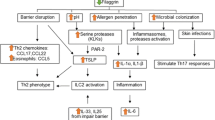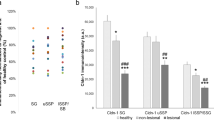Abstract
Atopic dermatitis is characterized by disruption of the cutaneous barrier due to reduced ceramide levels even in non-lesional dry skin. Following further acute barrier disruption by repeated tape strippings, we re-characterized the non-lesional dry skin of subjects with atopic dermatitis, which shows significantly reduced levels of barrier function and ceramide but not of beta-glucocerebrosidase activity. For the first time, we report an abnormal trans-epidermal water loss homeostasis in which delayed recovery kinetics of trans-epidermal water loss occurred on the first day during the 4 days after acute barrier disruption compared with healthy control skin. Interestingly, whereas the higher ceramide level in the stratum corneum of healthy control skin was further significantly up-regulated at 4 days post-tape stripping, the lower ceramide level in the stratum corneum of subjects with atopic dermatitis was not significantly changed. In a parallel study, whereas beta-glucocerebrosidase activity at 4 days post-tape stripping was significantly up-regulated in healthy control skin compared with before tape stripping, the level of that activity remained substantially unchanged in atopic dermatitis. These findings indicate that subjects with atopic dermatitis have a defect in sphingolipid-metabolic processing that generates ceramide in the interface between the stratum corneum and the epidermis. The results also support the notion that the continued disruption of barrier function in atopic dermatitis non-lesional skin is associated with the impaired homeostasis of a ceramide-generating process, which underscores an atopy-specific inflammation-triggered ceramide deficiency that is distinct from other types of dermatitis.






Similar content being viewed by others
Abbreviations
- AD:
-
Atopic dermatitis
- HC:
-
Healthy control
- SC:
-
Stratum corneum
- TEWL:
-
Trans-epidermal water loss
- BGCase:
-
β-Glucocerebrosidase
- aSMase:
-
Acid sphingomyelinase
- aCDase:
-
Acid ceramidase
- LG:
-
Lamellar granule
References
Angelova-Fischer I, Mannheimer AC, Hinder A, Ruether A, Franke A, Neubert RH, Fischer TW, Zillikens D (2011) Distinct barrier integrity phenotypes in filaggrin-related atopic eczema following sequential tape stripping and lipid profiling. Exp Dermatol 20:351–356
Arikawa J, Ishibashi M, Kawashima M, Takagi Y, Ichikawa Y, Imokawa G (2002) Decreased levels of sphingosine, a natural anti-microbial agent, may be associated with vulnerability of the stratum corneum from patients with atopic dermatitis to colonization by Staphylococcus aureus. J Invest Dermatol 119:433–439
Di Nardo A, Wertz P, Giannetti A, Seidenari S (1998) Ceramide and cholesterol composition of the skin of patients with atopic dermatitis. Acta Derm Venereol 78:27–30
Fartasch M, Bassukas ID, Diepgen TL (1992) Disturbed extruding mechanism of lamellar bodies in dry non-eczematous skin of atopics. Br J Dermatol 127:221–227
Feingold KR, Man MQ, Proksch E, Menon GK, Brown BE, Elias PM (1991) The lovastatin-treated rodent: a new model of barrier disruption and epidermal hyperplasia. J Invest Dermatol 96:201–209
Hanifin JM, Rajka G (1980) Diagnostic features of atopic dermatitis. Acta Derm Venereol (Stockh) 92 (Suppl.):44–47
Hara J, Higuchi K, Okamoto R, Kawashima M, Imokawa G (2000) High-expression of sphingomyelin deacylase is an important determinant of ceramide deficiency leading to barrier disruption in atopic dermatitis. J Invest Dermatol 115:406–413
Hata M, Tokura Y, Takigawa M, Sato M, Shioya Y, Fujikura Y, Imokawa G (2002) Assessment of epidermal barrier function by photoacoustic spectrometry in relation to its importance in the pathogenesis of atopic dermatitis. Lab Invest 82:1451–1461
Higuchi K, Hara J, Okamoto R, Kawashima M, Imokawa G (2000) The skin of atopic dermatitis patients contains a novel enzyme, glucosylceramide sphingomyelin deacylase, which cleaves the N-acyl linkage of sphingomyelin and glucosylceramide. Biochem J 350:747–756
Holleran WM, Feingold KR, Man M-Q, Gao WN, Lee JM, Elias PM (1991) Regulation of epidermal sphingolipid synthesis by permeability barrier function. J Lipid Res 32:1151–1158
Holleran WM, Man MQ, Gao WN, Menon GK, Elias PM, Feingold KR (1991) Sphingolipids are required for mammalian epidermal barrier function. Inhibition of sphingolipid synthesis delays barrier recovery after acute perturbation. J Clin Invest 88:1338–1345
Holleran WM, Takagi Y, Menon GK, Legler G, Feingold KR, Elias PM (1993) Processing of epidermal glucosylceramides is required for optimal mammalian cutaneous permeability barrier function. J Clin Invest 91:1656–1664
Holleran WM, Ginns EI, Menon GK, Grundmann JU, Fartasch M, McKinney CE, Elias PM, Sidransky E (1994) Consequences of beta-glucocerebrosidase deficiency in epidermis. Ultrastructure and permeability barrier alterations in Gaucher disease. J Clin Invest 93:1756–1764
Holleran WM, Takagi Y, Menon GK, Jackson SM, Lee JM, Feingold KR, Elias PM (1994) Permeability barrier requirements regulate epidermal beta-glucocerebrosidase. J Lipid Res 35:905–912
Imokawa G, Abe A, Jin K, Higaki Y, Kawashima M, Hidano A (1991) Decreased level of ceramides in stratum corneum of atopic dermatitis: an etiologic factor in atopic dry skin? J Invest Dermatol 96:523–526
Imokawa G, Kuno H, Kawai M (1991) Stratum corneum lipids serve as a bound-water modulator. J Invest Dermatol 96:845–851
Imokawa G, Yada Y, Higuchi K, Okuda M, Ohashi Y, Kawamata A (1994) Pseudo-acylceramide with linoleic acid produces selective recovery of diminished cutaneous barrier function in essential fatty acid deficient rats and has an inhibitory effect on epidermal hyperplasia. J Clin Invest 94:89–96
Imokawa G (1999) Skin moisturizers: development and clinical use ceramides. In: Loden M (ed) Dry skin and moisturizers. CRC Press, Boca Raton, pp 269–299
Imokawa G (2002) Ceramides as natural moisturizing factors and their efficacy in dry skin. In: Leyden JJ, Rawlings AV (eds) Skin moisturization. Marcel Dekker Inc., New York, pp 267–302
Imokawa G (2004) Surfactant-induced depletion of ceramides and other intercellular lipids: implication for the mechanism leading to dehydration of the stratum corneum. Exog Dermatol 3:81–98
Ishibashi M, Arikawa J, Okamoto R, Kawashima M, Takagi Y, Oguchi K, Imokawa G (2003) The abnormal expression of the novel epidermal enzyme, glucosylceramide deacylase and the accumulation of its enzymatic reaction product, glucosylsphingosine in the skin of patients with atopic dermatitis. Lab Invest 88:397–408
Ishikawa J, Narita H, Kondo N, Hotta M, Takagi Y, Masukawa Y, Kitahara T, Takema Y, Koyano S, Yamazaki S, Hatamochi A (2010) Changes in the ceramide profile of atopic dermatitis patients. J Invest Dermatol 130:2511–2514
Jensen JM, Fölster-Holst R, Baranowsky A, Schunck M, Winoto-Morbach S, Neumann C, Schütze S, Proksch E (2004) Impaired sphingomyelinase activity and epidermal differentiation in atopic dermatitis. J Invest Dermatol 122:1423–1431
Jin K, Higaki Y, Takagi Y, Higuchi K, Yada Y, Kawashima M, Imokawa G (1994) Analysis of beta-glucocerebrosidase and ceramidase activity in atopic and aged dry skin. Acta Derm Venereol 74:337–340
Jungersted JM, Scheer H, Mempel M, Baurecht H, Cifuentes L, Høgh JK, Hellgren LI, Jemec GB, Agner T, Weidinger S (2010) Stratum corneum lipids, skin barrier function and filaggrin mutations in patients with atopic eczema. Allergy 65:911–918
Kikuchi K, Kobayashi H, O’goshi K, Tagami H (2006) Impairment of skin barrier function is not inherent in atopic dermatitis patients: a prospective study conducted in newborns. Pediatr Dermatol 23:109–113
Kusuda S, Cui CY, Takahashi M, Tezuka T (1998) Localization of sphingomyelinase in lesional skin of atopic dermatitis patients. J Invest Dermatol 111:733–738
Mao-Qiang M, Feingold KR, Elias PM (1993) Inhibition of cholesterol and sphingolipid synthesis causes paradoxical effects on permeability barrier homeostasis. J Invest Dermatol 101:185–190
Masukawa Y, Narita H, Shimizu E, Kondo N, Sugai Y, Oba T, Homma R, Ishikawa J, Takagi Y, Kitahara T, Takema Y, Kita K (2008) Characterization of overall ceramide species in human stratum corneum. J Lipid Res 49:1466–1476
Masukawa Y, Narita H, Sato H, Naoe A, Kondo N, Sugai Y, Oba T, Homma R, Ishikawa J, Takagi Y, Kitahara T (2009) Comprehensive quantification of ceramide species in human stratum corneum. J Lipid Res 50:1708–1719
Matsuki H, Kiyokane K, Matsuki T, Sato S, Imokawa G (2004) Re-characterization of the non-lesional dry skin in atopic dermatitits through disrupted barrier function. Exog Dermatol 3:282–292
Matsuki H, Kiyokane K, Matsuki T, Sato S, Imokawa G (2004) Re-evaluation of the importance of barrier dysfunction in the non-lesional dry skin of atopic dermatitis through the use of two barrier creams. Exog Dermatol 3:293–302
Motta S, Monti M, Sesana S, Caputo R, Carelli S, Ghidoni R (1993) Ceramide composition of the psoriatic scale. Biochim Biophys Acta 1182:147–151
Murata Y, Ogata J, Higaki Y, Kawashima M, Yada Y, Higuchi K, Tsuchiya T, Kawaminami S, Imokawa G (1996) Abnormal expression of sphingomyelin acylase in atopic dermatitis: an etiologic factor for ceramide deficiency? J Invest Dermatol 106:1242–1249
Nogami-Itoh M, Teranishi Y, Kuwahara H, Kusumoto M, Nakamura K, Matsumoto M, Sakai J, Kimura T, Kawashima M (2010) Purification and identification of sphingomyelin deacylase from rat skin. J Invest Dermatol 13 (Suppl.2):s24
Okamoto R, Arikawa J, Ishibashi M, Kawashima M, Takagi Y, Imokawa G (2003) Sphingosylphosphorylcholine levels are significantly increased in the stratum corneum of patients with atopic dermatitis: physiological and functional relevance of sphingomyelin deacylase to the ceramide deficiency. J Lipid Res 44:93–102
Palmer CN, Irvine AD, Terron-Kwiatkowski A, Zhao Y, Liao H, Lee SP, Goudie DR, Sandilands A, Campbell LE, Smith FJ, O’Regan GM, Watson RM, Cecil JE, Bale SJ, Compton JG, DiGiovanna JJ, Fleckman P, Lewis-Jones S, Arseculeratne G, Sergeant A, Munro CS, El Houate B, McElreavey K, Halkjaer LB, Bisgaard H, Mukhopadhyay S, McLean WH (2006) Common loss-of-function variants of the epidermal barrier protein filaggrin are a major predisposing factor for atopic dermatitis. Nat Genet 38:441–446
Sandilands A, O’Regan GM, Liao H, Zhao Y, Terron-Kwiatkowski A, Watson RM, Cassidy AJ, Goudie DR, Smith FJ, McLean WH, Irvine AD (2006) Prevalent and rare mutations in the gene encoding filaggrin cause ichthyosis vulgaris and predispose individuals to atopic dermatitis. J Invest Dermatol 126:1770–1775
Sandilands A, Smith FJ, Irvine AD, McLean WH (2007) Filaggrin’s fuller figure: a glimpse into the genetic architecture of atopic dermatitis. J Invest Dermatol 127:1282–1284
Schmuth M, Man MQ, Weber F, Gao W, Feingold KR, Fritsch P, Elias PM, Holleran WM (2000) Permeability barrier disorder in Niemann–Pick disease: sphingomyelin–ceramide processing required for normal barrier homeostasis. J Invest Dermatol 115:459–466
Smith FJ, Irvine AD, Terron-Kwiatkowski A, Sandilands A, Campbell LE, Zhao Y, Liao H, Evans AT, Goudie DR, Lewis-Jones S, Arseculeratne G, Munro CS, Sergeant A, O’Regan G, Bale SJ, Compton JG, DiGiovanna JJ, Presland RB, Fleckman P, McLean WH (2006) Loss-of-function mutations in the gene encoding filaggrin cause ichthyosis vulgaris. Nat Genet 38:337–342
Takagi Y, Nakagawa H, Higuchi K, Imokawa G (2005) Characterization of surfactant-induced skin damage through barrier recovery induced by pseudoacylceramide. Dermatology 211:128–134
Takagi Y, Kriehuber E, Imokawa G, Elias PM, Holleran WM (1999) Beta-glucocerebrosidase activity in mammalian stratum corneum. J Lipid Res 40:861–869
Tanaka M, Zhen YX, Tagami H (1997) Normal recovery of the stratum corneum barrier function following damage induced by tape stripping in patients with atopic dermatitis. Br J Dermatol 136:966–967
Yoshida N, Sawada E, Imokawa G (2012) A reconstructed human epidermal keratinization culture model to characterize ceramide metabolism in the stratum corneum. Arch Dermatol Res 304:563–577
Acknowledgments
We thank Ms Chiharu Honma, Yukari Takeno and Mari Kawauchi for their excellent technical assistance.
Conflict of interest
The authors have no conflict of interest to declare.
Author information
Authors and Affiliations
Corresponding author
Rights and permissions
About this article
Cite this article
Sugiura, A., Nomura, T., Mizuno, A. et al. Reevaluation of the non-lesional dry skin in atopic dermatitis by acute barrier disruption: an abnormal permeability barrier homeostasis with defective processing to generate ceramide. Arch Dermatol Res 306, 427–440 (2014). https://doi.org/10.1007/s00403-013-1430-x
Received:
Revised:
Accepted:
Published:
Issue Date:
DOI: https://doi.org/10.1007/s00403-013-1430-x




